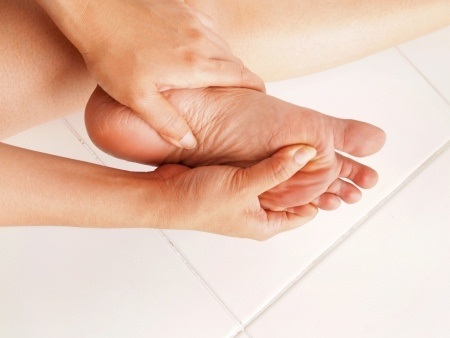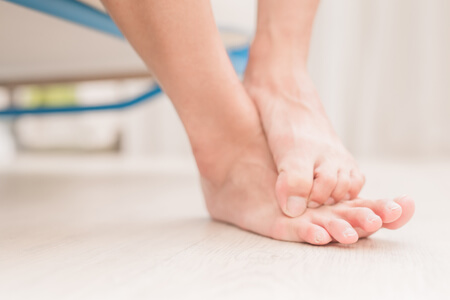Dallas (214) 340-8885
Athens (903) 677-9090
Gun Barrel City (903) 887-4341
Dallas (214) 340-8885
Athens (903) 677-9090
Gun Barrel City (903) 887-4341

Feet have the important task of bearing our entire weight and keeping us mobile. The heel part of the foot, in particular, endures a lot of impact and stress. Because of this, heel pain is a common occurrence for many people. For some it is just mild pain, but for others, it can be debilitating and affect mobility. Treating heel pain will depend on the cause of the pain, from injuries to genetic disease, and tissue strain.
Here are some common causes of heel pain and ways to prevent and treat them.
Peripheral Neuropathy – Burning pain along the bottom of the foot and heel can also be caused by plantar fasciitis and peripheral neuropathy. At the onset of diabetic neuropathy, you can experience a burning sensation as you lose feeling. At the onset of any burning feeling, or if you have been diagnosed with diabetes, make sure you check your feet and get an assessment with our podiatrist.
Are you concerned with ongoing heel pain that just won’t go away? Contact your local podiatrist at Texas Foot Works. Dr. Jonathan M. Kletz is more than happy to discuss this topic more in detail and find solutions for any problems you may come across. Make an appointment today at any of our Abrams (Dallas), Athens, and Gun Barrell City, TX offices!

Folks who have been diagnosed with diabetes will quickly learn that there are many changes they must make in their lives. From checking their blood sugar levels to changing their diet and activities, there are many lifestyle changes involved. This includes checking the feet daily in case of secondary issues that arise due to the way diabetes affects the body.
The following are common secondary issues that affect the feet for people who have diabetes:
Make sure you treat your feet well to prevent incidence of secondary issues. Check them daily and take care of any issues that arise sooner than later. If any foot-related developments occur, it’s best to see our podiatrist quickly.
If you have further questions about diabetic foot complications, contact your local podiatrist at Texas Foot Works. Dr. Jonathan M. Kletz is more than happy to discuss this topic more in detail and find solutions for any problems you may come across. Make an appointment today at any of our offices in Abrams (Dallas), Athens, and Gun Barrell City, TX!

Most of the population doesn’t even know that some people suffer from hyperhidrosis. If you’re among those who don’t know what it is, it’s essentially a condition in which people experience excessive sweating on certain parts of the body. Most of excessive sweating happens on the hands and feet, but can be in the armpit and the body overall. There isn’t a particular known cause, other than the fact that it is inherited. There isn’t even a known solution to stop the excessive sweating – only some short-term treatments to reduce the sweating.
The biggest concern for hyperhidrosis is more of a social aspect of embarrassment and discomfort, rather than a severe health issue. A handshake or taking shoes off at a friend’s house can be embarrassing. A clammy handshake or smelly wet socks are not something that most people are comfortable with. Furthermore, sweaty feet can mean slipping on slick floors, which can lead to injury.
There are, however, some health-related side effects. Due to the constant wetness on the feet, skin can break down if not properly cared for. Bacterial, viral, or fungal infections can be common and may not resolve as easily. Additionally, foot odor can affect all shoes and become an emotional stress for those affected.
Things you can do to reduce problems with sweating and risk of infection:
Some treatment options include:
Is your hyperhidrosis severely affecting your quality of life? Come see our podiatrist, Dr. Jonathan M. Kletz of Texas Foot Works. Make an appointment today at any of our offices in Abrams (Dallas), Athens, and Gun Barrell City, TX to find the right solution for your excessive sweating problems.
Unless it becomes painful, you may not even notice that you have a plantar wart, which can look like calloused skin. In fact, some can come and go without needing treatment. But when they don’t go away, they can become annoying and unsightly. Taking your shoes off, especially at a friend’s house during summer would feel like a no-no.
So what can you do about it?
First, be sure to spread love, not warts. Plantar warts are caused by the Human Papillomavirus (HPV) and are contagious through direct contact, shared towels and clothes, or while walking barefoot in locker room floors. The virus enters the skin through any breaks in the skin, such as cuts or scrapes. To prevent spreading warts, make sure you don’t share towels or socks, and use flip-flops in communal areas.
Second, you can try some home treatments using over-the-counter items.
Third, if over-the-counter treatments do not work, our podiatrist can treat you in the office using stronger cryotherapy or chemicals. He can also safely surgically remove some of the hardened skin.
Finally, take prevention measures. If you’ve been infected, the virus may live on in your body and reappear. However, to prevent a new infection, make sure to keep your feet clean. Wash your feet each day and fully dry them. Moisturize if necessary and treat any cuts or scrapes. Also, wear flip-flops in communal areas in which people might be going barefoot. And don’t be part of the problem – don’t go barefoot in communal areas when you’ve got an active plantar wart!
Do you have wart problem that won’t go away or has gotten out of hand? Come see our podiatrist, Dr. Jonathan M. Kletz of Texas Foot Works. Make an appointment today at any of our Abrams (Dallas), Athens, and Gun Barrell City, TX offices.
You’ve probably seen products for corn removal and callus pads at your local drugstores and supermarkets. You may have wondered about them, and who would need them. Or maybe you’ve had corns and calluses, but they haven’t gotten better. Well, we’re going to talk about your options today.
Corns and calluses develop due to constant repeated friction on the skin of your feet. Thick skin that forms as a bump is called a corn, while thick skin that develops on the bottom of the feet are called a callus. If you’ve had them, you know that not only are they unpleasant to look at, but they can also cause you pain. Unfortunately, the most likely culprit is your footwear.
That’s right, if your shoes are constantly rubbing on feet, the friction will cause your skin to thicken to protect itself. However, the longer it develops, the more likely it is that you may feel pain.
While they are not contagious or life-threatening, they sure can be a huge nuisance. Here are some questions to ask yourself for dealing with corns and/or calluses:
If you have pesky corns and calluses that are bothering you, our podiatrist can help remove or reduce them. Make an appointment at Texas Foot Works to have your feet checked and to find the best solution to treat them. Our podiatrist Jonathan M. Kletz, DPM can treat your feet at our offices in Dallas, Athens and Gun Barrell City, TX.